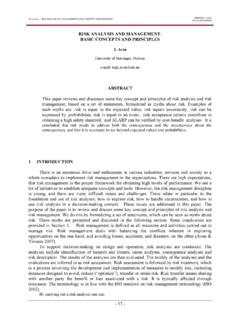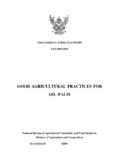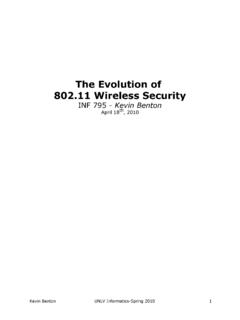Transcription of RISK MANAGEMENT: PROCEDURES, METHODS AND …
1 Heinz Peter Berg RISK management : PROCEDURES, METHODS AND EXPERIENCES RT&A # 2(17) ( ) 2010 , June 79 RISK management : PROCEDURES, METHODS AND EXPERIENCES Heinz-Peter Berg Bundesamt f r Strahlenschutz, Salzgitter, Germany e-mail: ABSTRACT Risk management is an activity which integrates recognition of risk, risk assessment, developing strategies to manage it, and mitigation of risk using managerial resources. Some traditional risk managements are focused on risks stemming from physical or legal causes ( natural disasters or fires, accidents, death).
2 Financial risk management , on the other hand, focuses on risks that can be managed using traded financial instruments. Objective of risk management is to reduce different risks related to a pre-selected domain to an acceptable. It may refer to numerous types of threats caused by environment, technology, humans, organizations and politics. The paper describes the different steps in the risk management process which METHODS are used in the different steps, and provides some examples for risk and safety management .
3 1 INTRODUCTION Risk Risk is unavoidable and present in every human situation. It is present in daily lives, public and private sector organizations. Depending on the context (insurance, stakeholder, technical causes), there are many accepted definitions of risk in use. The common concept in all definitions is uncertainty of outcomes. Where they differ is in how they characterize outcomes. Some describe risk as having only adverse consequences, while others are neutral.
4 One description of risk is the following: risk refers to the uncertainty that surrounds future events and outcomes. It is the expression of the likelihood and impact of an event with the potential to influence the achievement of an organization's objectives. The phrase "the expression of the likelihood and impact of an event" implies that, as a minimum, some form of quantitative or qualitative analysis is required for making decisions concerning major risks or threats to the achievement of an organization's objectives.
5 For each risk, two calculations are required: its likelihood or probability; and the extent of the impact or consequences. Finally, it is recognized that for some organizations, risk management is applied to issues predetermined to result in adverse or unwanted consequences. For these organizations, the definition of risk which refers to risk as "a function of the probability (chance, likelihood) of an adverse or unwanted event, and the severity or magnitude of the consequences of that event" will be more relevant to their particular public decision-making contexts.
6 Heinz Peter Berg RISK management : PROCEDURES, METHODS AND EXPERIENCES RT&A # 2(17) ( ) 2010 , June 80 Risk management Two different safety management principles are possible: consequence based safety management will claim that the worst conceivable events at an installation should not have consequences outside certain boundaries, and will thus design safety systems to assure this. Risk based safety management (usually called risk management ) maintains that the residual risk should be analysed both with respect to the probabilistic and the nature of hazard, and hence give information for further risk mitigation.
7 This implies that very unlikely events might, but not necessarily will, be tolerated. Risk management is not new tool and a lot of standards and guidance documents are available (ACT 2004, AZ/NZS 2004, Committee 2004, DGQ 2007, FAA 2007, HB 2004, IEC 2008, ON 2008, Rio Tinto 2007, Treasury Board of Canada 2001). It is an integral component of good management and decision-making at all levels of an organization. All departments in an organization manage risk continuously whether they realize it or not, sometimes more rigorously and systematically, sometimes less.
8 More rigorous risk management occurs most visibly in those departments whose core mandate is to protect the environment and public health and safety. At present, a further generic standard on risk management is in preparation as a common ISO/IEC standard (IEC 2007) describing a systemic top down as well as a functional bottom up approach (see Fig. 1) This standard is intended to support existing industry or sector specific standards. Figure 1. Approach of the planned generic standard on risk management .
9 As with the definition of risk, there are equally many accepted definitions of risk management in use. Some describe risk management as the decision-making process, excluding the identification and assessment of risk, whereas others describe risk management as the complete process, including risk identification, assessment and decisions around risk issues. Heinz Peter Berg RISK management : PROCEDURES, METHODS AND EXPERIENCES RT&A # 2(17) ( ) 2010 , June 81 One well accepted description of risk management is the following: risk management is a systematic approach to setting the best course of action under uncertainty by identifying, assessing, understanding, acting on and communicating risk issues.
10 In order to apply risk management effectively, it is vital that a risk management culture be developed. The risk management culture supports the overall vision, mission and objectives of an organization. Limits and boundaries are established and communicated concerning what are acceptable risk practices and outcomes. Since risk management is directed at uncertainty related to future events and outcomes, it is implied that all planning exercises encompass some form of risk management .









